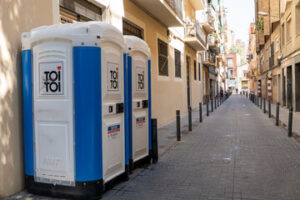Whether for an event or a construction project, the right Restroom Trailer Rental size can mean comfort and convenience for your guests or workers. Portable restroom trailers range in size from two to ten toilets and may have added features, such as hand washing stations or ADA accessibility.

Some also look like the cottage from Hansel and Gretel. With options such as these, deciding on the best restroom trailer size can be tricky.
The Number Of People
The first consideration when choosing the perfect portable restroom trailer for your event is how many people you expect to attend. This number will help you determine the number of toilet stalls and other amenities that are needed. A good rule of thumb is to have one restroom per 50 attendees for events that last up to four hours. If the event is longer, then you should increase the number of restrooms by a factor of two or three to account for multiple usages over time.
The type of event or construction project can also affect the number of restrooms required. For example, a wedding will have many different requirements than a commercial remodel at a restaurant.
It is best to collaborate with a restroom trailer rental company when determining how many toilets are needed for your particular event. They will have the experience and expertise to help you make a decision based on your specific needs and expectations. They can also provide suggestions for additional features and accessibility options that will enhance your guest or worker experience.
Restroom trailers come in a wide range of sizes to meet a variety of needs. The smallest option is a two-stall portable restroom, which is ideal for smaller events or construction sites with limited space. This model provides a toilet, urinal, sink, and hand sanitizer dispenser. Larger events may require a more upscale portable restroom rental, such as a five-stall or eight-station restroom trailer. These larger units offer a more luxurious experience with additional amenities such as heated floors, decorative walls and flooring, and soap dispensers.
The length of the event will also affect how often guests or workers need to use the restrooms. For example, a two-hour outdoor concert will likely see less usage than a 12-hour corporate event. The more people attend the event, the more frequent the restroom usage will be, and it is recommended to rent a few more portable toilets than you anticipate to accommodate unexpected demand.
Another factor to consider when calculating the number of restrooms required is the percentage of attendees who will need handicap-accessible units. This is important because you must meet the minimum requirements outlined by the Americans with Disabilities Act for each restroom location. It is generally best to have one handicap-accessible porta-potty for every 20 portable restrooms.
The Duration Of The Event
Depending on how many people you expect to attend, the amount of time your event lasts, and the weather conditions, restroom usage will vary. It’s a good rule of thumb to plan for one toilet stall per 25 people throughout an eight-hour event. Having extra stalls on hand will help prevent long lines and keep everyone happy.
It’s also important to factor in the types of activities your guests will participate in, including eating and drinking. This will lead to more frequent toilet trips. If your event involves getting muddy or sweaty (like a Tough Mudder), guests may want to shower more frequently.
If you’re planning an event for a multi-day period, you may need to rent multiple trailer bathrooms to accommodate the number of attendees over several days. This is especially important if you anticipate families attending your event and need to provide facilities for children and infants. You should also consider whether you need ADA-compliant toilets to accommodate guests with disabilities.
A longer duration will require more regular servicing of your portable toilets and sink trailer. The grey and black waste tanks will need to be emptied, and the freshwater tank will need to be filled regularly. You will also need to replace toilet paper and soap, and the trailer will need to be cleaned.
If your event is scheduled to occur over several days, you may need multiple trailer bathrooms on site to ensure that all of your guests have access to clean and comfortable facilities. Luxury restroom trailers offer an upscale experience with amenities like flushing toilets, running water in sinks, mirrors, and climate control. These trailers are a great option for weddings and other formal outdoor events.
For a more economical rental, you can opt for standard portable toilets that have two or three separate stalls. These units are ideal for a wide variety of special events, from weddings to festivals and fundraisers. They are also a great choice for construction projects, providing workers with the convenience of toilets and sinks that are mobile and easy to set up.
The Location
As you can imagine, the location of your event will play a big part in determining restroom trailer size and style. You want to be sure that your guests have convenient access to restrooms, but you also need to take into account the environment and weather conditions. If you are hosting a large outdoor event, you may need to consider more portable bathrooms than if you were organizing a small indoor gathering. This is because the number of people attending an outdoor event can quickly increase and it can be difficult to manage bathroom usage.
In addition, if you are organizing an event that will attract guests with special needs, such as the elderly or disabled, you will need to ensure that there are enough portable restrooms in the right sizes for them to use. This is especially important for events that are hosted in public places such as parks, stadiums, and beaches. If you are hosting an event that will have a lot of young children, you will also need to make sure that you have enough portable toilets to accommodate them.
Another consideration is the duration of your event or project. If you are only needing the restroom trailer for a few hours, you can probably get away with renting a smaller unit. However, if you are renting a restroom trailer for an entire day or even multiple days, it is best to go with a larger option to ensure that the trailer can handle the amount of usage over time.
Once you have considered the above factors, it is time to find a restroom trailer rental company that can offer the right options for your needs. Make sure that you select a company that has years of experience in the industry and a reputation for excellence. They should be able to answer any questions that you might have about portable restrooms including their delivery and pickup policies, rental rates, and available amenities. They should also be able to help you select the right portable bathroom for your event or project.
The Type Of Event
When it comes to selecting a portable restroom trailer for your event or project, there are many factors to consider. You’ll need to determine the number of attendees or workers that you need to accommodate, what type of facilities they are looking for, and whether or not your venue is suitable for a mobile bathroom. Then, you’ll need to decide on the size and features of the trailer that best meets your needs. Finally, you’ll need to choose a company that offers delivery, setup, and breakdown services to help make your event or project a success.
The type of event that you are hosting can also impact the number and type of restrooms you need. For example, more formal events or those that last longer may require larger or more upscale restroom trailers with additional amenities. Additionally, if your event will involve getting sweaty or muddy, you may want to include shower trailers on site so that people can take a rinse-off after the event.
Compared to standard porta potties, restroom trailers provide more private toilet stalls and are equipped with amenities like flushing toilets, sinks, mirrors, and air conditioning. This makes them the perfect option for more upscale events such as weddings or festivals. These high-end portable restrooms are available in various sizes with options for multiple stalls, sinks, and showers.
Another factor to consider when determining the number and size of restrooms you need is whether or not alcohol will be served. This will affect how frequently the toilets will need to be serviced and could also lead to a higher usage of water and electricity than normal. If you’re planning to serve alcohol at your event, it’s recommended that you use a slightly more conservative estimate when calculating the number of toilet stalls needed.
Once you have determined the number of restroom stalls required, you’ll need to ensure that there is enough space at your location for the trailer and any additional services you may need, such as power and water hookups (if applicable). You should also ensure that there is room to queue outside of the trailer and that it will be located away from any obstacles or barriers, including overhanging trees and power lines.


